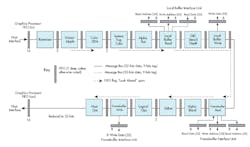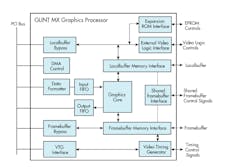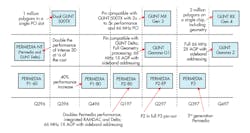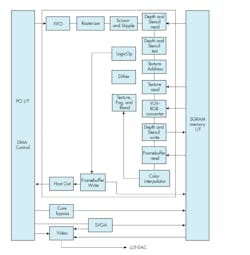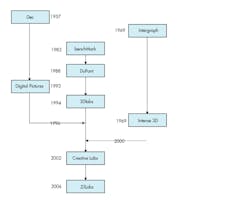3Dlabs: From Glint to Permedia
This article is part of the Electronics History series: The Graphics Chip Chronicles
3Dlabs was founded in April 1994 and announced the Glint 3D rasterizing engine for high-end 3D CAD applications in November of that year.
Glint was the first fully integrated, OpenGL-compatible workstation graphics chip. Other companies such as ATI, Dynamic Pictures, and Nvidia would also develop OpenGL workstation-class chips, while more established companies – Evans & Sutherland, HP, IBM, Intergraph, SGI, SUN, and others often referred to as “big iron” companies – designed large graphics boards with multiple proprietary processors. All of these “big iron” companies would succumb to the economic advantages of single-chip designs and the economies of scale behind them. Over time, the “big iron” suppliers would adopt single-chip parts or retreat from the market – as DEC, E&S, IBM, Intergraph, Lockheed, SGI, and SUN did. By 2000, these companies had started exiting the graphics market and the long painful process of shrinking. Some, like DEC, did not make it.
The first Glint chips offered the equivalent of a high-end Silicon Graphics Indigo graphics product in a single chip – at a lower cost than the VRAM frame buffer memory. The Glint chips provided 24-bit 2D and 3D acceleration, an on-chip PCI interface, and LUT-DAC control, making a complete graphics subsystem possible with minimal chip count.
Smaller, more agile companies kept pushing the technology and, in 1997, 3Dlabs developed its Glint Gamma processor, the first programmable transform and lighting (T&L) engine for its Glint workstation graphics chips. It even coined the term GPU – geometry processor unit, before Nvidia announced its graphics processor unit (GPU) years later. 3Dlabs’ GPU was a separate chip called Delta. Before Delta, T&L was done by the floating-point processor in the CPU and, in some cases, with DSPs.
Whereas 3Dlabs GMX was a co-processor to the Glint SX and MX rasterizer, Nvidia developed an integrated T&L engine for their consumer graphics chips, under the GeForce brand. ATI quickly followed with their Radeon graphics chip. By the end of 1999, the number of graphics chip suppliers had dropped to twelve, and the consolidation was not over yet. Even though the market was rapidly expanding, commodity suppliers were dying out.
The Glint 300 SX was manufactured in 1994 using IBM’s 3.3V, 0.5-micron process, and it operated at 2.5 billion operations/second and sold for $150 in volume.
Right on the heels of the Glint SX, 3Dlabs introduced the Glint TX. Both the 300SX and 300TX featured very advanced designs. They each contained one million transistors and ran at the equivalent of 2.5 Giga Operations per second. In contrast, a typical VGA chip of the time incorporated 50,000 transistors.
Glint was designed to process primitives (such as triangles) that were generated by an application and passed to Glint via the OpenGL API. Glint was referred to as a rendering pipeline processor.
Triangles were passed through the pipeline and messages were generated as to what should happen at each stage. The primitives were Gouraud shaded Z buffered triangles, with dithering.
The application generated the triangle vertex information and made the necessary OpenGL calls to draw it.
The OpenGL server/library would take the vertex information, transform, clip and light it. It would then calculate the initial values and derivatives to interpolate position and color depth. All those values were in fixed point integer format and had unique message tags. Some of the values (the depth derivatives) had more than 32 bits to cope with (for dynamic range and resolution) and were sent in two parts. Finally, once the derivative’s start and end values had been sent to Glint the ‘render triangle’ message was sent.
In computer graphics, a digital differential analyzer (DDA) is hardware or software used for the interpolation of variables over an interval between start and endpoint. DDAs are used for the rasterization of lines, triangles, and polygons.
In Glint, the derivative, start, and end parameter messages were received and flowed down the message stream to the appropriate function blocks. The depth parameters and derivatives were sent to the Depth Unit; the RGB parameters and derivative to the Color DDA Unit; the edge values and derivatives were sent to the Rasterizer Unit.
The ‘render triangle’ message was received by the rasterizer unit and all subsequent messages (from the host) were blocked until the triangle had been rasterized (but not necessarily written to the frame store). A 'prepare to render' message would be passed on so any other blocks could prepare themselves.
3Dlabs continued to expand the product line and, in 1997, introduced a smaller, faster model: the Glint MX. The MX was a high-performance graphics processor that combined workstation-class 3D graphics acceleration and state-of-the-art 2D performance in a single chip. The MX accelerated all the 3D rendering operations, including Gouraud shading, texture mapping, depth buffering, antialiasing, and alpha blending. Implemented around a scalable memory architecture, the MX reduced the cost and complexity of 3D graphics within a windowing environment. It was pin-compatible with the 300SX and 500TX processors.
The Glint rasterizers and OpenGL accelerators delivered what the company promised but were being held back by the processing speed and I/O of the CPU’s floating-point capability. 3Dlabs knew that would be a problem and had hoped Moore’s law would solve the issue. But it never did. And so, the company developed its own FFP but as a dedicated geometry processor rather than an inherently slower general-purpose FFP—they called it the Delta processor, and it was designed to be a co-processor to the Glint.
While initially targeting traditional 3D applications including CAD, 3Dlabs envisioned the long-term market would span games and multimedia to VR and interactive television. And although the company did partner (somewhat coyly, it turned out later) with Creative Labs, 3Dlabs in the consumer marketplace was still some ways off with its Permedia.
The market was still wide open. Windows NT 4.0 was a year away, and the applications base that 3Dlabs needed was still two years away. So, between 1994 and 1996, anything to do with professional 3D graphics was considered fair game. Intel bought into Lockheed Martin’s 3D intellectual property, knowing that even back in 1995, the company was weighing its options in a Windows-dominated world.
What 3Dlabs did that no other manufacturer had managed to do was to completely focus on their PC OEM customers. Industry insiders looked at Intel’s roadmap and Microsoft’s roadmap and figured out – like Compaq had – that UNIX was their next target. This was a time when the PC industry stood on the brink of world domination and was looking for foes to vanquish. This was also a time when Apple was seeming to lose ground, and companies hit by a recession were looking to save money without giving up progress.
The company’s other coup was to sell professional graphics to an audience that knew nothing about it. Much of the interest in PCs in the mid-1990s was surrounding multimedia. 3Dlabs sang the praises of the sexiest component, the one that was out of the reach of most users and developers: real-time 3D. It helped to have SGI preening around in full glory at the same time, splashing Hollywood special effects over traditionally staid computer shows. It also helped to have a host of APIs promising to enable the next generation in mass-market 3D applications. Remember Reality Labs and Intel’s 3DR?
The initial problem 3Dlabs faced in promoting the market was one many companies face today: the PC versus workstation debate. Ultimately, 3Dlabs and other like-minded companies understood that workstations were used for professional graphics and that until customers had a compelling reason to do so, they would not switch to the PC. It is worth bearing in mind that in the pre-Windows 95 and NT 4.0 eras it was not completely clear that the PC would not end up being a 3D game machine and nothing else. There was also some level of confusion around how much software rendering was going to be done by APIs such as RenderWare and Reality Lab. The PC graphics market was caught a little flat-footed by the professional graphics market.
3Dlabs wasn’t. Neither were the companies who bought into their technology: Elsa, SPEA, Omnicom, and, eventually, AccelGraphics. These companies, big or small, still carried with them the experience and expertise of AutoCAD graphics sales and were bolstered by workstation savvy developers. SIGGRAPH 94 was the beginning of momentum behind OpenGL, and Microsoft was showing its support for the API by including it in the beta CD for Daytona, which would eventually go on to become the NT platform of version 3.0.
Permedia
In 1995, the company introduced its Permedia graphics processor. With Permedia, 3Dlabs answered all complaints its competition had against the Glint (too expensive, too high-end, no VGA, no PCI, only uses VRAM, requires Z-buffer). Its technology partnership with IBM was paying dividends: 3.3V 0.35µ fabrication, a special version of the 562-process, and VGC/PCI capability. The chip, with its 3D Blaster game compatibility and its long list of OEM proponents, ushered in a new wave of game boards for the PC. The chip sold for $50.
3Dlabs continued to pick up the established workstation customers. And, in 1996, TI would renew its interest in graphics by licensing 3Dlabs’ design for the Permedia.
The advantage ATI, Nvidia, and others had was that they could adapt the chips they were developing for the consumer market to smaller-volume professional graphics platforms. To counteract this, 3Dlabs announced a lower-cost version of its high-end chip, the Permedia. Creative Labs was one of the first to adopt the new chip. But as good as it was, the chip could never reach the price points and design cycles that ATI and Nvidia were hitting and 3Dlabs found itself losing market share and sales.
The company had gone public in April 1994 and, armed with more financial firepower in the form of stock, started seeking acquisitions to broaden its capabilities.
In July 1996, 3Dlabs acquired rival Dynamic Pictures. Dynamic Pictures spun out of DEC in 1993. Digital developed 3D chips at its Palo Alto design center in the early 1990s and then, as the company began retrenching and selling off assets, it closed the facility. Dynamic Pictures was then founded in 1993. The founders worked for eight years at DEC where they developed 3D graphics workstation products including the ZLX-M/L graphics line. The technology was originally developed as part of the PixelVision project within DEC.
The First T&L Processor
In November 1997, at the Comdex conference, 3Dlabs announced two new high-performance chipset families in its Glint family: the Glint DMX and the Glint GMX (code-named Gamma). These chipsets provided geometry and rasterization performance and accelerated the same 3Dlabs 2D/3D driver set. The company claimed at the time that they would accelerate graphics tasks such as transforms, lighting, clipping, and texture-mapping rates to 66 million pixels per second.
Both Glint DMX and GMX families supported high-resolution displays up to 2000 × 2000 pixels at true color, large texture memories up to 96 MB, and deep 32-bit color & Z-buffers. Both chipsets also accelerated OpenGL 1.1 rendering operations, including Gouraud shading, advanced texture-mapping, per-pixel mipmapping, tri-linear texture filtering, anti-aliasing, multi-plane stenciling, and alpha blending with destination alpha support. By February 1998, the company was providing sample quantities of the GMX to selected OEM customers.
3Dlabs also developed what was the first, multi-chip implementation of a geometry processing unit – a GPU. However, they called it a Video Processing Unit or VPU. But when Nvidia introduced the first fully-integrated graphics processor unit or GPU, 3Dlabs reconsidered the naming.
In 1999, some workstations used a new high-speed serial memory called RDRAM developed by Rambus. And, in 1999, 3Dlabs introduced the Glint Rx that used Rambus for its memory—the first graphics chip to do so.
Then, in April 2000, 3Dlabs announced it would acquire the Intense3D division of Intergraph. Intergraph’s Intense3D division had developed the 3D-T Pro 1000, which was competitive with to 3Dlabs boards. As part of the deal, 3Dlabs agreed it would continue to supply Intergraph with graphics products for its workstations and media processing products.
Paradise Lost
The origins of 3Dlabs started in 1983 when Osman Kent and Yavuz Ahiska started Benchmark Technologies in London. They sold benchMark to DuPont in 1988 for $12 million, and it became DuPont Pixel.
The managers of DuPont Pixel made—and DuPont DuPont accepted—a buyout offer, and in 1994 3Dlabs was established. The company immediately released details on the Glint family of 3D graphics processors — the 300SX and 300TX — in April 1994.
The company developed a series of high-performance graphics processors and entered the consumer segment with its popular Permedia processor in 1995.
It then acquired two competitors, strengthening its position in the workstation segment. But larger companies including ATI and Nvidia overwhelmed 3Dlabs with faster product introductions and lower prices due to the economies of scale of supplying the emerging PC gaming and commercial segments.
When the Internet bubble popped, 3Dlabs was losing money and market share and could no longer compete.
In June 2002, Creative Labs, the company’s long-time partner, bought it out. Then, at the start of 2005, Creative Labs shut down the workstation business of 3Dlabs and announced it would stop developing professional 3D graphic chips and focus on embedded and mobile media processors. The new media processor products, developed by most of the workstation graphics chip designers in the original 3Dlabs R&D center, were designated ZiiLabs.
In December 2006, Creative Labs spun off 3Dlabs and created ZiiLabs, with a lot of the same R&D engineers from the Benchmark Technologies days.
In July 1993, the consumer version was developed with Creative Labs, giving 3Dlabs the distinction of being one of the first companies to ship a 3D gaming chip, called “Gigi.”
The ELSA add-in board at the top of this article is equipped with a 3Dlabs setup and rendering engines as well as 40 MB of onboard RAM. The ELSA GLoria-XL ($1,650) was nonetheless a lackluster performer on most benchmarks in 1998. The GLoria-XL was built around 3Dlabs' Delta geometry processor and Glint MX rendering chip, with a 16 MB VRAM frame buffer and up to 40 MB of EDO DRAM texture memory, which produces 24-bit double-buffered resolutions up to 1920 pixels by 1080 pixels.
3Dlabs was a pioneer, the first to implement OpenGL in silicon, the first to build a commercial geometry and lighting engine, and the first to use Rambus and drive massive texture maps. The company’s IP portfolio still runs through the industry and is a source of comfort for a handful of companies because of the foundational protections it offers.
About the Author

Jon Peddie
President
Dr. Jon Peddie heads up Tiburon, Calif.-based Jon Peddie Research. Peddie lectures at numerous conferences on topics pertaining to graphics technology and the emerging trends in digital media technology. He is the former president of Siggraph Pioneers, and is also the author of several books. Peddie was recently honored by the CAD Society with a lifetime achievement award. Peddie is a senior and lifetime member of IEEE (joined in 1963), and a former chair of the IEEE Super Computer Committee. Contact him at [email protected].


